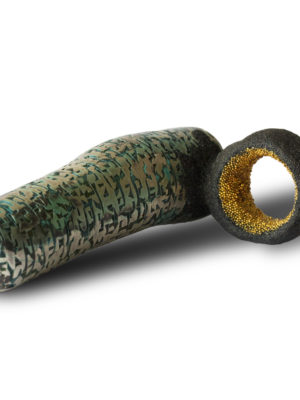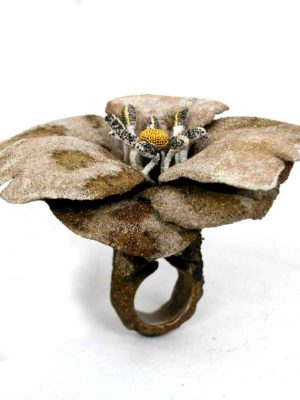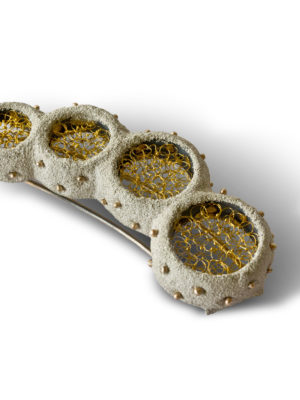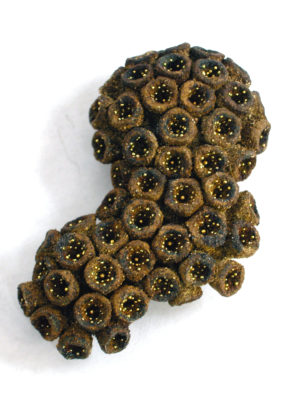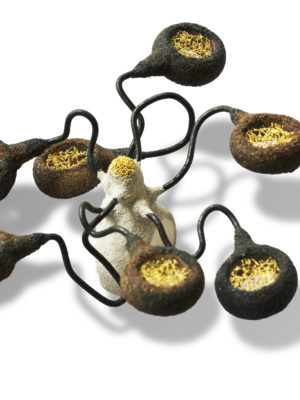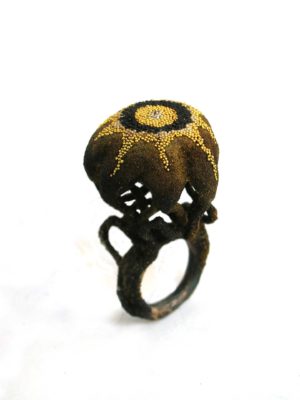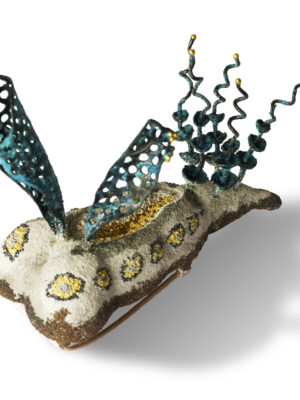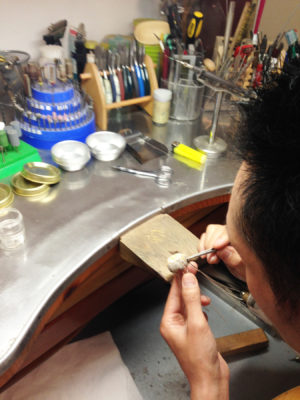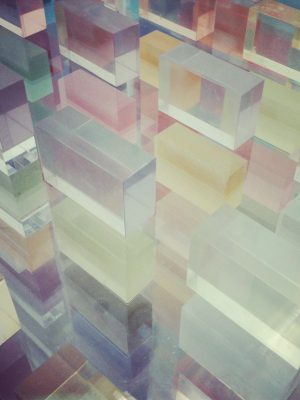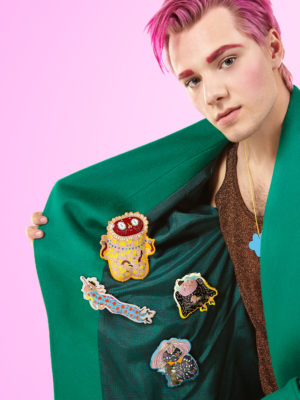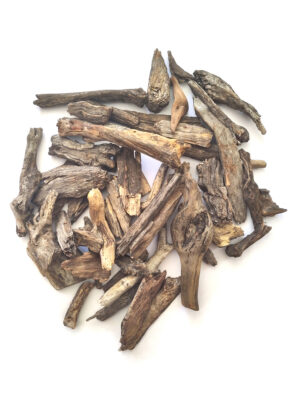Kellie Riggs: You’ve been busy lately – you’ve been recently acquired by the Cooper-Hewitt Museum in New York, have just come back from a solo show at Mobilia gallery in Massachusetts, participated in an exhibition at Galerie Orfèo in Luxembourg, and now have had a solo presentation at Florence Jewellery Week. How do you keep up with all of this demand? And how are you feeling about the year you’ve had?
Arata Fuchi: I don’t sleep. I have a passion to create my work so I am able to do a lot in the studio without a lot of sleep. I am always prepared and very well organized, and it’s easy for me to plan out my work schedule to meet all of these demands. I feel great, because lot of people now can see my pieces at the museum. Right now they are organizing a show that will include the work they bought recently, and I’m very excited about this. For me it’s magnificent – that the audience feels something when they look at what I do – even if they think it’s ugly or beautiful, I am happy if something remains within the person that sees it. So it’s been nice that my work has been able to go so many places this year.
Who are you collectors? Is it your preferred audience?
I don’t know. I don’t know who they are because the galleries don’t tell me. They are mostly American of a certain age. I don’t exactly have a preferred audience, anyone who feels connected to my work, I am happy that they have it. In Florence it is much more difficult, people only by my work that is much simpler and wearable, if anything. The more difficult work is also appreciated, but here there isn’t a market of collectors like there is in America or other parts of Europe.
Do you call yourself an artist or a craftsman? Does this distinction matter to you?
To me it doesn’t matter – metalsmith, artist, craftsman – I do what I want and my audience can call me whatever they feel like. Everyone has their opinion about what it means to be a maker and that’s up to them. I just make what I want to make and these definitions aren’t so important to me.
What about in Japan – are these definitions different, or how does the relationship between the two concepts work?
Artigiano è artigiano – craft is craft – how can I say it, traditional craft, whatever it is, even a traditional chef, it takes 20 to over 40 years to become an real artisan. Until a certain age you are still just an apprentice. It can take at least thirty years, or even all your life. It’s not the same for an artist. For the person that says they are an artist, they can be. The two things are not the same, or earned in the same way. When a person starts to express themselves creatively, they can immediately be considered an artist. These two things are very separate for Japanese people, but for foreigners, when they see a handmade sword in Japan for example, which Japanese people consider to be craft, they consider it to be both.
I think you were the only artist in the FJW programming that actually lives and works in Florence, Italy. What brought you here and why have you stayed for so long?
It’s been over ten years that I’ve been here. I originally came to learn how to make jewellery. I thought I would return to Japan after two years, because I was a watch designer there. I thought to learn jewellery skills and open a store back in Japan. But when I got to Florence I learned about artistic jewellery, I didn’t know about it before, and I became passionate about it. Before I learned anything in Japan, I thought I always wanted to be an artist, from when I was eighteen years old. But I learned I wasn’t able to be an artist, I didn’t have it in me. I quit that idea, and I decided to become a watch designer instead (and sometimes jewellery). But I eventually left that work because it was too stressful. While studying in Florence, I discovered contemporary jewellery or artistic jewellery, and my passion for that grew. Then I was twenty-six years old, and I realized I could kind of do both, be an artist in another way by bringing my design skills into this new craft. It was the perfect union. I stayed here because it was more comfortable to continue this work in Florence instead of in Japan. Back home there isn’t a strong market for what I do. They appreciate name brand stuff from other countries, so it was better to stay abroad – there is more value to my work if I make it here rather than making it in Japan – this idea of ‘Made in Italy’ is more interesting to them there.
What is your studio like?
I work in a shared studio space called Officine Nora in the Santo Spirito neighbourhood of Florence, where many of the traditional craft botteghe remain. There are six of us from all over the world, and there we are able to share experiences and help each other if need be. We also have some of our pieces on display and are open to the public. Each of us is specialized in different jewellery techniques.
Do you have a local audience? Or can you reflect on the scene in Florence when it comes to the appreciation of contemporary craft?
Florence is actually a difficult city to sell things. People expect classic things, which I don’t quite do. And Florentines don’t spend money on this kind of jewellery either. I don’t know a lot of wealthy people here – and the foreigners that come buy from Ponte Vecchio. So I’m here for this aspect of making jewellery in Italy, but not so much to sell it here, because it’s extremely difficult. I sell most of my creations in other countries. I do think it is appreciated culturally, but personally people don’t invest in it anymore, the handmade. They like to see it, look at it, know how it’s made – but owning it is another thing. Florence is like one big museum so people come here to see things, not to buy contemporary craft unfortunately. It finished in the Renaissance! They like to see real and true things, but not to have them for themselves. At least that is the way it seems to me. I’ve never really sold my things to Fiorentini, only foreigners. In America for example, if they like it, they buy it. It’s much more simple.
How would you describe your work? What is important for you to convey with your pieces? You can answer this via concept or in materiality, whatever is important to you as a maker.
To tell the truth, I don’t like concepts, not even to think of titles of pieces. I think of titles after I’ve finished a piece because it’s not important to me. Same with the concept- maybe I can’t explain everything I am feeling with words, so I just do it. I just make the object. The object is the concept, if that makes sense. For me it’s working with the materials and techniques that give me satisfaction, and people can see what they want in it. It’s up to them.
You are actually a master at certain techniques in your jewellery making. Can you describe some of them?
Principally I use the technique e of keum-boo – which is an ancient Korean technique of applying pure gold leaf onto a silver service. I developed another technique using very fine gold wire to create fields of delicate mesh and texture; and I also developed an original technique of pulverization using silver dust to cover an entire object, giving it a rough but beautiful texture.
Is it true you’ve adapted some techniques especially for your pieces that you keep as a secret?
For now, yes, but in the future I’m not sure. Let’s see… right now I don’t know! Maybe in fifty years or when I feel like I’m finished making jewellery, or if the right person comes a long, I will share the techniques. But I can’t really say.
How do you relate to the word technology? Is there any room for new technology in any sense in your making practice? Why or why not?
This is difficult for me to answer. Technology… I don’t know. We can create anything, so surely technology exists. It’s important for expressing personal identity maybe and so everyone has to find their own new technology right for them. If they use the same material always, with the same technics, everything becomes the same, right? But if someone finds a new way to do something, a new technique, this becomes identity. It can then become technology I guess – it’s just about personal research to advance your artistic practice or concept, whatever works best for that, not just for jewellery but art in general – music, painting sculpture, etc. But I do use classical techniques and materials, I like the colour and feel of metal – so technology for me as we know it isn’t important, it’s fine and great, but for me it’s just about pushing the boundaries of my own techniques to create something new. It’s about change, or developing something new from something old. It’s kind of difficult for me to explain.
How is jewellery important to you?
It’s not. I was a watch designer, and then jewellery designer, but I’d also like to make sculpture, and do other things. I’m not that attached to it as a medium itself, because like I said I’m more attracted to the materials and techniques. I remember before my father died I called my mother, and she left the phone next to my father and he answered surprisingly. He couldn’t speak because of his sickness, but I made a promise to him, that I would achieve success with my work, whatever it was– that I would take it as far as I could, as best as I could, and at that moment it was jewellery that I was making. That’s why I continue with it. And will continue with it, until I feel as though I’ve been successful. He agreed; I asked him if he wanted to see my success, and he said yes. He wanted this for me too. So I made him this promise and that’s why I continue to work.
To you, what does it mean to be successful?
Just to feel satisfied. Satisfaction after all, is personal.
Introduction to series:
Florence, Italy, isn’t usually synonymous with contemporary anything – and despite its appreciation for the handmade, and its long history of being an important town for jewellery and goldsmithing (think Ponte Vecchio), contemporary jewellery rather, is still an off-the-beaten path anomaly. But for the last few years, for five days in late spring, it attempts to become Florence’s main attraction via Florence Jewellery Week.
Since 2005 Le Arti Orafe has been presenting PREZIOSA – a cultural initiative with contemporary jewellery at its focus. In 2008 PREZIOSA Young was introduced as well in order to promote the work of talented emerging makers in jewellery. And in recent years LAO’s ambition has expanded even further under the umbrella of FJW. As such, the project has been able to extend their programming that this year involved a two day conference with ten speakers, seven separate exhibitions, four jewellery workshops, various receptions and concerts, and the participation of three independent studios of LAO alumni.
The interview above is part of a short interview series (commissioned by LAO) that aims to shed light on the perspectives of seven of this year’s participants chosen by the author: Curators Kevin Murray and Inger Wästberg, artist Arata Fuchi, and this year’s four PREZIOSA Young winners, Qian Wang, Xiaodai Huang, Fang Yin Yeh, and Shachar Cohen.
This particular interview was conducted in person in Italian and Fuchi’s answers were translated into english by the author. All other interviews were conduced via email.
